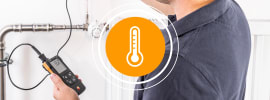Guidelines and standards for food
Insufficient cooling or heating of food is one of the most common causes of food poisoning. Use Testo’s reliable measuring instruments to comply with food standards and guidelines – to ensure that food is safe.
Improve food safety
Comply with HACCP guidelines and EN standards
Whether it’s incoming goods, production, transport, storage, food preparation or sale - Testo offers the perfect solution

HACCP guidelines
HACCP stands for “Hazard Analysis and Critical Control Points” and is an internationally binding quality management system for food. The HACCP guidelines define temperature limits for all products and stipulate that evidence of compliance with temperatures is mandatory. Testo measuring instruments, which come with a HACCP International certificate, can support you in food safety and compliance with the HACCP regulations.
HACCP-compliant products
Penetration thermometers, infrared thermometers, data loggers
Further directives and standards
EN 13485
The EN 13485 standard defines the requirements thermometers must fulfil for use in the food industry. The requirements relate, for example, to the method of measurement (contact/penetration measurement), the measuring range, measuring accuracy and the measuring instrument resolution.
testo 103 - penetration thermometer
testo 104 - penetration thermometer
testo 105 - penetration thermometer
testo 106 - food thermometer
testo 108 - temperature measuring instrument
testo 108-2 - temperature measuring instrument with lockable probe
testo 110 - temperature measuring instrument
testo 735-1 - temperature measuring instrument (3-channel) (with connectable probe)
testo 735-2 - temperature measuring instrument (3-channel)
testo 926 - temperature measuring instrument
testo 104-IR - penetration/infrared thermometer
testo 826-T4 - penetration/infrared thermometer
testo 826-T2 - infrared thermometer

The HACCP concept – basic information and background
In the 1950s, the race into space between the USA and the Soviet Union was in full swing. And once Moscow produced the Sputnik in 1957, the Americans launched their peak planning stage for a manned space flight. One important aspect of this project was food safety in space. The food had to be 100% safe - anything else could have catastrophic consequences.
To develop safe astronaut food, NASA worked closely with the Pillsbury food company. To carry out this task, Pillsbury applied an existing concept of the US military. The aim was to prevent mistakes from the outset, rather than discovering and correcting them later on. HACCP was the result. It proved its worth very quickly, and was being used worldwide by 1985 – 16 years after the successful moon landing.
HACCP stands for “Hazard Analysis and Critical Control Points”.
HACCP is an internationally binding quality management system for food.
The HACCP guidelines stipulate that proof of temperature compliance is absolutely essential.
Compliance with the HACCP regulations is strictly controlled in many countries.
This involves preventive measures for hazard analysis, as well as critical control points in the process chain.
The HACCP control system sets temperature limits for all products.
Testo measuring instruments can help you achieve food safety and compliance with HACCP regulations.
Hazard analysis
Critical control points
Limit values
Continuous monitoring
Correction measures
Documentation
Regular verification

Legal framework conditions for implementing HACCP in the catering trade
Food legislation prescribes proof of adherence to the cold chain and sufficient heating of the food before serving. This proof is provided in the form of the written documentation of the measurements carried out. The restaurateur must ensure that measurements are taken with sufficient frequency to ensure food safety.
The objective is continuous and uninterrupted monitoring of the products and the production steps. This is especially important for the CCPs (Critical Control Points), which are crucial to the HACCP concept. CCPs are critical points at which a risk to the guests’ health can occur due to lack of food hygiene. An important example is the adherence to limit values in core temperature measurement.
In food management in catering, this principle applies: “If it’s not documented, it doesn’t exist.” This is why the authorities impose fines for non-compliance with the HACCP concept. In the worst case scenario – e.g. when there are serious shortcomings in food hygiene – the food inspectors close the restaurant.
The various challenges show that having the right measuring technology is an important building block for a company’s success in the food industry. Good measuring instruments should fulfil the following criteria:
Accurate results: so you can deliver impeccable quality
Robust workmanship: this includes protection from splashes and water jets for better hygiene
Certified quality: tested according to EU norms and HACCP International
Easy to use: minimize measurement and operating errors
Safe handling: protection against hazards (e.g. hot oil)

Need to comply with HACCP guidelines? With Testo's measuring technology and expertise, it's easy.
Food is a matter of trust. Its safety and impeccable quality are taken for granted by the customers. This, of course, poses great challenges for food business operators along the entire cold chain: What do I need to watch out for? Which measuring technology is recommended? And who can provide me with information about new regulatory developments that affect my day-to-day business? Fortunately, Testo is on hand to help you with advice, support, expert knowledge plus, of course, the appropriate measuring technology.
Of course, even the best expertise is of no use to you at all if you do not also have the appropriate measuring technology to apply what you have learned in your day-to-day business. Testo measuring instruments for food are designed to provide you with reliable support when working with food. Because we are familiar with the big challenges and small details of these applications and have geared our products precisely to them. Whether it’s a moisture meter, penetration thermometer or cooking oil tester – food measuring instruments that leave our plants are robust, resistant, protected against water ingress and have the relevant certificates and approvals.



























